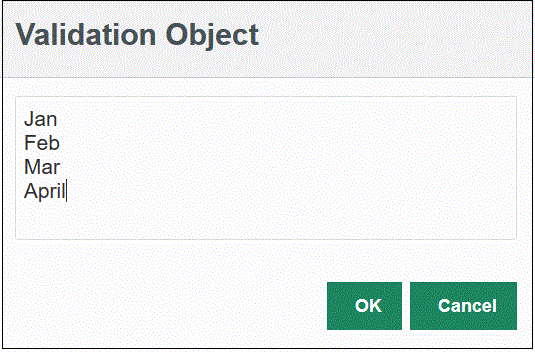Applying Application Filters to an Oracle ERP Cloud Data Source
All application filters are predefined when you select any of the prepackaged queries to the Oracle ERP Cloud sources. However, you can provide input values in integration options.
You can select dynamic filters to define as report parameters from the Oracle ERP Cloud data source when the actual parameter value needs to be defined at the run integration or application level.
An example of a dynamic filter is "Currency Type" where you can select either: Entered, Statistical, or Total.
You can specify a single filter condition or multiple filters conditions, and additionally specify the exact values that you want returned.
In some cases, you can change a static parameter value in the Report parameter list by replacing it with a parameter value enclosed within $$ notations. This type of filter applies to the Ledger ID and Period parameters.
For example, you can add the static parameter
value argument1 = $LEDGER_NAME$
to the Report Parameter List as a parameter.
On the Edit Options page, a display name has been entered for the parameter. This is the name as it is shown on the Options page:

This is how the parameter shows on the Options tab in the integration definition:

Two predefined parameters, $START_PERIODKEY$ and $END_PERIODKEY$, can be used to select specific periods using a data format from the POV. For information on using these two parameters, see Selecting Period Report Parameters from the Oracle ERP Cloud.
To add a filter for the Oracle ERP Cloud data source.
-
From the Application page, click
 to the right of the Oracle ERP Cloud data source and then select Edit
Options.
to the right of the Oracle ERP Cloud data source and then select Edit
Options.
-
From the Edit Options page, click Add (
 ).
).
A blank entry line display.
-
Select any parameters to pass by completing the following:
-
In the Name field, specify the name of the parameter.
-
In Display Prompt, enter the name of the display prompt for the filter on the Source Options tab in Data Management or Edit Integration page in Data Integration.
-
In Display Order, specify the display order of the filter on the Source Options or Edit Integration page.
For example, enter 99 to show the filter in the 99th position sequence or position in a list of filters. Display orders are listed from lowest to highest.
If this field is blank, the custom filter cannot be displayed, and the default value is used as the filter value.
-
In Property Level drop-down, select display level of the parameter (application, integration or both application and integration) to indicate the level at which the filter is displayed.
-
To provide a drop-down of values listed using the lookup type, in Validation Type, select one of the following
- None
- Number
- Lookup Validate
- Lookup No Validate
- Yes/No
- Date
- Query
- Choice list—You can enter a list of values in the Validation Object field. Each value is entered on a new line. The list of values (LOV) on the Option page shows the values as a list.
For example, to set the Canceled Invoices Only option to "No,", select No in the parameter field for Canceled Invoice Only.
-
In Validation Object, enter a list of lookup objects to be validated by type.
To enter a list of values if you chose the Choice list validation type above, click
 , then enter the list of values on the
Validation Object page, and then click
OK.
, then enter the list of values on the
Validation Object page, and then click
OK.

-
-
In Condition List, provide a condition list based on one or all the following:
- EQ (Equal)
- IN
- Like
The condition values can be
Equal,Like, orIn. The condition values are stored as a drop-down list in CONDITION_LIST field. If the value isEQ,IN, then show onlyEqualandInin the Condition drop down. If the value isEQ LIKE, then show only Equal, Like in the drop down. Any combination ofEQ,IN,LIKEare stored in the field. If only one value is provided in the Condition List, then the condition cannot be changed. The default value isEQ. When specifying multiple conditions, prefix the condition with a comma. For example, to use theINandLIKEconditions, enter:,IN,LIKE - Optional Click Save.